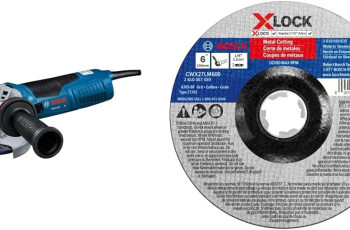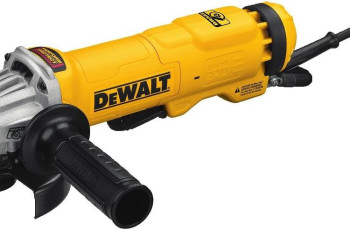Angle grinders are versatile and powerful tools that are commonly used in construction and metalworking. However, they also pose a potential danger due to the risk of kickback – a sudden and violent backward movement of the tool. This article focuses on the importance of kickback prevention in angle grinders and explores various strategies to mitigate this risk. By understanding the causes of kickback and implementing the recommended preventive measures, you can ensure safer and more efficient operation of angle grinders.
Understanding Kickback in Angle Grinders
What is kickback?
Kickback refers to the sudden and violent force that can occur when an angle grinder’s rotating disc is forcefully stopped or jammed. This force can cause the grinder to kick back towards the user, posing a significant danger. Kickback is a common occurrence in angle grinders and can result in serious injuries if not properly managed.
Causes of kickback
There are several factors that can lead to kickback in angle grinders. One primary cause is the improper handling of the tool, such as holding it loosely or using excessive force. Another common cause is using an incorrect disc for the task at hand, as different materials require specific disc types. Additionally, a poorly maintained or worn-out angle grinder can lead to increased kickback risks.
The dangers of kickback
Kickback poses significant dangers to the user and those nearby. The sudden jerk of the grinder can cause loss of control and result in severe injuries, including lacerations, fractures, and even amputations. The high speed and force of the kickback can propel the grinder towards the user’s face, hands, or other vulnerable areas. Understanding and implementing effective safety measures is crucial to prevent kickback accidents.
Safety Measures Before Using an Angle Grinder
Inspect the tool
Before using an angle grinder, always inspect it thoroughly. Check for any cracks, missing parts, or faulty switches. Ensure that the disc is properly mounted and securely fastened. Any signs of wear or damage should be addressed immediately, and the grinder should not be used if there are any safety concerns.
Wear appropriate protective gear
When operating an angle grinder, it is essential to wear proper protective gear to minimize the risk of injury. This includes safety goggles or a face shield to protect the eyes from flying debris, ear protection to minimize noise exposure, and heavy-duty gloves to shield the hands from potential hazards. Additionally, wearing a dust mask or respirator can help prevent inhalation of harmful particles.
Secure the workpiece
Before starting any grinding task, make sure the workpiece is securely clamped or held in place. This will prevent it from shifting or moving during operation, reducing the risk of kickback. Using clamps, vices, or other secure holding mechanisms will provide stability and ensure safer working conditions.
Clear the work area
Before using an angle grinder, ensure that the work area is free of any potential hazards. Remove any objects, tools, or debris that could interfere with the operation or cause an accident. It is crucial to have a clean, well-organized workspace to prevent tripping, falling, or entanglement hazards.
Proper Handling Techniques to Minimize Kickback
Maintain a firm grip
To minimize the risk of kickback, always maintain a firm grip on the angle grinder. Hold the tool with both hands, ensuring that your hands are secure and positioned away from the spinning disc. Avoid holding the grinder with just your fingertips or using an unstable grip that can easily be disrupted in the event of a kickback.
Position your body correctly
Proper body positioning is vital when using an angle grinder to prevent kickback accidents. Stand with your feet shoulder-width apart for stability and balance. Position yourself to the side and slightly behind the grinder, ensuring that your body is not directly in line with the disc’s potential path in case of a kickback.
Use both hands to operate
Always use both hands to operate the angle grinder and maintain full control over the tool. Place one hand on the grip handle and the other hand on the auxiliary handle, ensuring a balanced and stable grip. This two-handed operation will increase your ability to control the grinder and reduce the risk of kickback.
Avoid excessive force
Using excessive force while operating an angle grinder can increase the chances of kickback. Allow the grinder to do the work by applying steady and moderate pressure. Avoid pushing or forcing the disc against the workpiece, as this can cause the grinder to kick back. Let the disc’s speed and the grinder’s weight provide the necessary cutting or grinding force.
Choosing the Right Angle Grinder for Better Control
Consider grinder power and speed ratings
When selecting an angle grinder, consider the power and speed ratings appropriate for your intended tasks. Higher power and speed can provide better cutting and grinding performance, but they also require stronger control. Choosing a grinder with power and speed ratings suitable for your needs will provide better control and reduce the risk of kickback.
Opt for a model with adjustable handle
An angle grinder with an adjustable handle allows for better control and improved ergonomics. Adjusting the handle to a comfortable position can enhance grip stability and reduce the risk of fatigue. This, in turn, helps maintain control over the grinder and minimizes the chances of kickback during prolonged use.
Choose a grinder with a clutch
Angle grinders equipped with a clutch feature are designed to minimize kickback accidents. The clutch mechanism automatically disengages the drive if the disc suddenly stops or jams, reducing the likelihood of a severe kickback. Investing in a grinder with a clutch can significantly enhance safety and prevent potentially dangerous kickback situations.
Utilizing Safety Features in Angle Grinders
Anti-kickback brake
Some modern angle grinders come with an anti-kickback brake feature. This safety mechanism senses sudden disc stoppage and triggers the brake, bringing the disc to a halt in a fraction of a second. The anti-kickback brake can effectively stop the grinder’s rotation, reducing the severity of a potential kickback.
Tool-less wheel guard
Angle grinders equipped with a tool-less wheel guard make it easier to adjust and position the guard for different grinding tasks. A properly positioned wheel guard provides an additional layer of protection by preventing debris from flying towards the user, reducing the likelihood of kickback accidents.
Electronic kickback detection
Advanced angle grinders may feature electronic kickback detection technology. This intelligent system monitors the grinder’s rotation speed and reacts to sudden changes, such as those caused by kickback. When kickback is detected, the grinder automatically stops within milliseconds, significantly increasing user safety.
Using the Correct Disc for the Task at Hand
Selecting the appropriate disc type
Using the appropriate disc type for the specific task is crucial in preventing kickback incidents. Different disc types are designed to cut or grind specific materials effectively, ensuring safe and efficient operation. It is essential to refer to the manufacturer’s guidelines and choose the correct disc for the material you are working on to minimize the risk of kickback.
Choosing the right disc size
Angle grinders come in various sizes, and it is important to select the right disc size for your intended application. Using a disc that is too large or too small for the grinder can lead to an imbalance that increases the risk of kickback. Always use a disc with a size compatible with your grinder to maintain stability and control.
Maintaining Your Angle Grinder for Optimal Performance
Regular inspection and cleaning
Regular inspection and cleaning of your angle grinder are essential for optimal performance and safety. Check the tool for any loose or damaged parts, inspect the cord for any signs of wear, and clean dust or debris that may have accumulated in or around the grinder. Performing these routine maintenance tasks will help ensure that your grinder operates smoothly and reduces the risk of kickback due to mechanical issues.
Keep the disc sharp and clean
Maintaining a sharp and clean disc is crucial to prevent kickback and achieve desired cutting or grinding results. Dull or clogged discs can cause excessive friction and increase the chances of kickback accidents. Regularly inspect the disc for wear or damage and replace it when necessary. Additionally, clean the disc after each use to remove accumulated debris and maintain optimal performance.
Knowing Your Workpiece and Its Limitations
Understanding the material being worked on
Before starting any grinding task, it is important to understand the characteristics and limitations of the material being worked on. Different materials may require specific grinding techniques or disc types, and using the wrong method can increase the risk of kickback. Familiarize yourself with the material’s properties and follow appropriate grinding guidelines to ensure safe and effective operation.
Respecting the grinder’s limitations
Every angle grinder has limitations in terms of speed, power, and capacities. It is essential to respect these limitations to avoid kickback accidents. Pushing the grinder beyond its capabilities can result in excessive stress on the tool, leading to increased kickback risk. Understand the manufacturer’s specifications and use the grinder within its intended limits for safe operation.
Best Practices to Prevent Kickback
Avoid high-risk situations
To minimize the risk of kickback, it is important to avoid high-risk situations whenever possible. These may include grinding near sharp edges, working on unstable surfaces, or using the grinder in cramped spaces. Recognize hazardous conditions and adjust your working methods accordingly to prevent kickback accidents.
Take breaks to prevent fatigue
Working with an angle grinder for extended periods can lead to fatigue, which can negatively impact your grip strength and control. Take frequent breaks during long grinding sessions to prevent fatigue and maintain proper focus and control. Fatigue-induced loss of control can increase the risk of kickback accidents, making breaks an important safety measure.
Seek proper training and guidance
Obtaining proper training and guidance on the safe use of angle grinders can significantly reduce the risk of kickback accidents. Seek out qualified professionals or training programs that provide comprehensive instruction on angle grinder safety. Understanding the proper techniques and precautions will improve your competence and confidence in using the tool, ensuring a safer working environment.
Emergency Preparedness for Kickback Situations
Understanding emergency stop procedures
In the event of a kickback, it is crucial to know how to quickly and safely stop the angle grinder. Familiarize yourself with the emergency stop procedures specific to your grinder model. This may involve releasing the switch or activating a designated emergency stop button. Understanding and practicing these procedures can help mitigate the potential harm caused by kickback accidents.
Having a first aid kit on hand
Due to the potential severity of kickback injuries, it is important to have a well-stocked first aid kit readily available in your work area. The kit should include essential supplies such as bandages, sterile dressings, antiseptic solutions, and gloves. Promptly addressing any injuries is crucial to minimize the risk of infection or further complications caused by kickback incidents.
By understanding kickback and implementing the necessary safety measures, you can greatly reduce the risk of accidents while using an angle grinder. Taking the time to choose the right grinder, utilize safety features, and maintain the tool properly will ensure optimal performance and minimize the chances of kickback. Remember to always prioritize your safety by wearing proper protective gear, using proper handling techniques, and seeking the necessary training and guidance. Prevention is key when it comes to kickback, and by following these guidelines, you can enjoy safe and efficient grinding operations.



